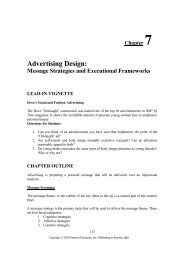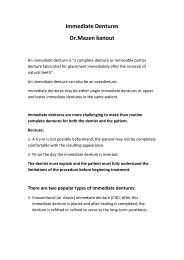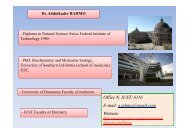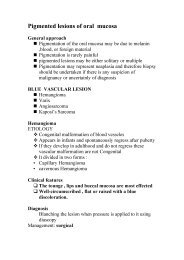Surgical instruments.pdf
Surgical instruments.pdf
Surgical instruments.pdf
Create successful ePaper yourself
Turn your PDF publications into a flip-book with our unique Google optimized e-Paper software.
<strong>Surgical</strong> <strong>instruments</strong><br />
DR.EYAD ABOU ASALI
Minor Surgery Tray
Minor Surgery Instruments<br />
• Lesions for minor surgery are generally small<br />
and readily accessible, thus minor surgery<br />
<strong>instruments</strong> are small.<br />
• Although use of fine <strong>instruments</strong> does not<br />
ensure meticulous operative technique, it tends<br />
to encourage more careful handling of tissues.<br />
• The quantity of each of the <strong>instruments</strong> required<br />
depends largely upon the number of minor<br />
surgical operations performed.
Basic pack<br />
good quality <strong>instruments</strong> and no cheap<br />
<strong>instruments</strong>
Scalpel<br />
• Best instrument for division of tissue<br />
• Less traumatic to surrounding tissues<br />
• Should be held in a way that will permit full<br />
control of the instrument and freedom of<br />
movement<br />
• Composed of the blade and the blade handle<br />
• Blades come in different sizes and shapes<br />
• Size of the blade does not change the technique<br />
of its use
Scalpel handle
Bard-Parker #4 scalpel handle
• Disposable scalpel
• #4 handle – for larger blades (#20)<br />
• #3 handle – for smaller blades (#10, 11,<br />
12, 15); commonly used in plastic surgery<br />
• #7 handle – ends of which are similar to<br />
#3 handle; commonly used in eye, ear,<br />
nose and throat work
• Blades #10 is the most commonly used<br />
scalpel blade<br />
• #15 is a smaller version of #10 and is used<br />
for more delicate incisions<br />
• Blade #15<br />
– used in most procedures, especially plastic<br />
surgeries, allowing more precise turns when<br />
making the incision
• Blade #11 (stab or bayonet)<br />
– Used for draining collections of pus by driving<br />
the point directly into the abscess and then<br />
sweeping the blade up through the tissue in<br />
an arc.<br />
– May be used in removing sutures
• Blade #12 (bistoury)<br />
– looks like a hook and used for draining<br />
infection of the middle ear; the tip sweeps<br />
through the drum in an arc<br />
– Can also be used in removing sutures
• The handle of the scalpel is grasped between the thumb<br />
and the 3 rd and 4 th fingers and the index finger placed<br />
over the back of the blade to provide firm control.<br />
• For cutting, a smooth sweep is made with the rounded<br />
portion of the blade rather than the point.<br />
• Since the blade is sharp, very little pressure is required;<br />
a light stroke over the tissue with the middle of the blade<br />
is adequate.<br />
• Long gentle cutting strokes are less traumatic to tissue<br />
than short chopping motions
Thumb Forceps<br />
• Consist of two tines held together at one end<br />
with a spring device that holds the tines open<br />
• Dressing forceps have smooth or smoothly<br />
serrated tips<br />
• Tissue forceps have teeth to grip tissue<br />
• Used to pick up tissue or hold tissue between<br />
the apposed surfaces<br />
• When teeth are present in the apposing<br />
surfaces, the forceps can hold the tissue without<br />
slipping and without exerting undue pressure.
• Forceps to be used in handling vital<br />
structures, those which should not be<br />
perforated, should have no teeth;<br />
additional grasping strength is provided for<br />
by a wider head.<br />
• Many forceps bear the name of the<br />
originator of the design, such as Adson<br />
tissue forceps.
• Tissue forceps<br />
– Has teeth which prevents it from slipping<br />
– Only a small amount of pressure is required to<br />
grasp the tissue firmly<br />
– Teeth vary in number from one to a dozen<br />
and in size from very fine to fairly large<br />
– Always used when handling skin
• Rat tooth<br />
– Interdigitating teeth to hold tissue without<br />
slipping<br />
– Used to hold skin/dense tissue
Rat-tooth (thumb)<br />
tissue forceps
Non-toothed forceps.
Toothed forceps.
Brown-Adson (thumb)<br />
tissue forceps
Dressing and Tissue Forceps<br />
• Adson tissue forceps<br />
– Small serrated teeth on edge of tips<br />
– Has delicate serrated tips designed for light,<br />
careful handling of tissue
Thumb Forceps<br />
• Forceps to be used in handling vital structures, those<br />
which should not be perforated, should have no teeth;<br />
additional grasping strength is provided for by a wider<br />
head.<br />
• Dressing forceps<br />
– Has a blunt end with coarse cross striations to give it additional<br />
grasping power<br />
– Used routinely in applying and removing dressings<br />
– Also used to handle a hollow viscus which might be punctured<br />
by a sharply pointed forceps<br />
– Not used to grasp the skin when putting in skin sutures; since<br />
there are no teeth on the grasping edges the force required to<br />
hold the skin firmly may be enough to cause necrosis.
Thumb Forceps
Dissecting forceps (twisors)
Adson (thumb) tissue forceps
• The forceps is held between the thumb<br />
and the middle and index fingers of either<br />
hand (“like a pencil”).<br />
• The forceps is not held like a knife.
Grasping Forceps<br />
• These <strong>instruments</strong> are designed primarily<br />
to take hold of tissues and allow one to<br />
exert traction.<br />
• The apposing surfaces of the individual<br />
heads vary a great deal depending on the<br />
specific purpose.<br />
• All have a set of finger rings and a locking<br />
mechanism.
• Allis Forceps<br />
– Its tip consists of apposing serrated edges<br />
with fairly short teeth<br />
– Slightly traumatic<br />
– Used for grasping fascia or breast tissue<br />
– Used for traction on the skin; it is not applied<br />
directly to the skin but rather on the tissue<br />
immediately beneath the skin<br />
– May also be used to hold wound drapes in<br />
place
Allis
• Babcock Forceps<br />
– More delicate than Allis, less directly<br />
traumatic<br />
– Broad, flared ends with smooth tips<br />
– Used to atraumatically hold viscera (bowel<br />
and bladder)
• Kocher Forceps<br />
– The blades have transverse serrations<br />
running along the full length and long sharp<br />
points are found at the tips.<br />
– Has considerable grasping power and allows<br />
one to exert a considerable amount of tension<br />
on tissues.<br />
– Commonly used on heavy fascia or bone; the<br />
tissue is unlikely to pull free when grasped<br />
with this forceps.
Kocher
• Sponge (ovum) forceps<br />
– Can be straight or curved<br />
– Can have smooth or serrated jaws<br />
– Used to atraumatically hold viscera (bowel<br />
and bladder)<br />
– Used to hold the sponge when prepping
Hemostatic Forceps<br />
• Hinged (locking) mechanism<br />
• Many bear the name of the designer<br />
(Kelly, Holstead, Crile)<br />
• Used to clamp and hold blood vessels<br />
• May be curved or straight
• Kelly and Mosquito Hemostats<br />
– Both are transversely serrated<br />
– Mosquito hemostats are more delicate, have<br />
smaller and finer tips than Kelly
Mosquito
Kelly
Kelly hemostatic forceps (curved<br />
and straight)
Carmalt hemostatic forceps<br />
(curved and straight)
Artery clips
Grasping Forceps<br />
• To manipulate the grasping forceps, the<br />
thumb and the 4 th fingers are inserted<br />
through the rings and the rings are<br />
apposed to lock.
Scissors<br />
• Used for division of tissues<br />
• Also used to cut sutures and dressings<br />
• Tissue scissors are usually lighter, have a finer cutting<br />
edge and smoother points than the suture scissors.<br />
• Straight scissors are used for work on the surface;<br />
curved scissors are used deeper in the wound.<br />
• Usually only the tip is used for cutting.<br />
• When a tough structure must be cut, the heel or the back<br />
portion of the blade is used so as not to spoil the blade<br />
near the tip.
• To avoid injury to vital structures, the scissors<br />
should never be closed unless the tips of the<br />
blades can be seen clearly, as in cutting sutures.<br />
• In cutting sutures, never attempt to cut a suture<br />
unless<br />
– You are in a good position<br />
– You have full control of the scissors<br />
– You can see the suture to be divided<br />
– You can see that you are not likely to cut any other<br />
structure
• Curved Mayo Scissors<br />
– Common to most surgical trays and used for<br />
cutting dense tissue where Metz scissors are<br />
too delicate.<br />
• Straight Mayo Scissors<br />
– General purpose and suture cutting scissors,<br />
normally not used on tissue.
Scissors
• Metzenbaum Scissors<br />
– Used for cutting delicate tissues<br />
– Have longer handle to blade ratio
• Bandage Scissors<br />
– Most common type has one blade with a flat<br />
blunt prow which can be inserted beneath a<br />
dressing and slid forward without fear of<br />
penetrating the skin.<br />
– Used mainly in cutting bandages and rarely<br />
used in operating table.
Scissors
Mayo dissecting scissor (top)<br />
Metzenbaum scissor (bottom)
Mayo dissecting scissor<br />
straight and curved
Suture scissors (blunt blunt)
Littauer suture scissors
• To hold the scissors, the thumb and the 4 th<br />
fingers are inserted through the rings, the middle<br />
finger is rested in front of the ring finger and the<br />
index finger is set against the blades.<br />
• The index finger placed well forward on the<br />
scissors provides more control of the instrument.<br />
• The instrument should remain at the tips of the<br />
fingers for maximum control.
Scissors
Retractors<br />
• May be hand held or self – retaining<br />
• Aid in exposure of the tissue or lesion<br />
being dissected
Farabeuf retractor
Retractors
Spay hook
• Hand Held Retractors:<br />
Zenn<br />
– Blades at each end<br />
– Blades can be blunt (delicate) or sharp (more<br />
traumatic, used for fascia)
Army Navy<br />
– Blunt edges with different lengths used in<br />
most minor procedures
• Hand held Retractors :<br />
Usually held by an assistant to aid the<br />
surgeon in the visualization of the lesion<br />
being dissected.
• Self retaining Retractors:<br />
Weitlaner<br />
– Ends can be blunt or sharp<br />
– Has rake tips<br />
– Ratchet to hold tissue apart
Gelpi<br />
– Has single point tips<br />
– Ratchet to hold tissue apart
Curettes
Periostal elevator
Needle Holder<br />
• Hinged (locking) instrument used to hold<br />
the needle while suturing tissue<br />
• Good quality is ensured with tungsten<br />
carbide inserts at the tip of the needle<br />
holder
• Mayo – Hegar<br />
– Heavy, with mildly tapered jaws<br />
– No cutting blades
• Olsen – Hegar<br />
– Includes both needle holding jaw and scissor<br />
blades<br />
– The disadvantage to having blades within the<br />
needle holder is the suture material may be<br />
accidentally cut.
• Castro – Viejo Needle Driver<br />
– Common to vascular, ophthalmic and delicate<br />
cosmetic surgeries<br />
– Comes in locking and non – locking varieties<br />
depending on the surgeon’s preference<br />
– Used for very fine suture in the 00000 and<br />
smaller range
Castro – Viejo
• Like other ringed <strong>instruments</strong>, the needle holder<br />
is held with the thumb and the 4 th fingers<br />
inserted through the rings, the middle finger is<br />
rested in front of the ring finger and the index<br />
finger is set against the handle.<br />
• Castro – Viejo needle drivers are usually<br />
“palmed” with the curved portion of the locking<br />
mechanism held between the thenar and<br />
hypothenar eminences of the thumb and little<br />
finger, respectively.
• Secure drapes<br />
Towel clamps<br />
• May also be used to hold tissue<br />
• Backhaus towel clamp<br />
– Locking forceps with curved, pointed tips









